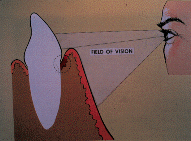|
14 Threepond
Road Smithtown, New York 11787 USA Phone: 516-858-0115 Fax: 516-596-8788 |
|
| |
Why measure GCF and what is
the significance?
Inflammation of the gingiva, usually referred to as gingivitis, arises in
the region of the crevicular epithelium well before any inflammation is
clinically visible.
|
| |
 This
is sometimes referred to as clinically invisible gingivitis. As the severity
of inflammation rises so does the level of GCF. In most cases, the
inflammation spreads to the marginal gingiva and the gingivitis becomes
clinically evident. Visual and tactile methods are used almost universally
by periodontists, hygienists and general practitioners alike to assess
visible gingivitis on a severity scale. The most common scale is that of
Loe-Silness (Periodontal disease in pregnancy. I. Prevalence and severity.
Acta Odontologica Scandinavica 21: 533, 1963). Usually referred to as the
Loe-Silness Index, this ranges from 0 to 3 where zero is no visible
gingivitis, and one is mild, two is moderate and three is severe gingivitis. This
is sometimes referred to as clinically invisible gingivitis. As the severity
of inflammation rises so does the level of GCF. In most cases, the
inflammation spreads to the marginal gingiva and the gingivitis becomes
clinically evident. Visual and tactile methods are used almost universally
by periodontists, hygienists and general practitioners alike to assess
visible gingivitis on a severity scale. The most common scale is that of
Loe-Silness (Periodontal disease in pregnancy. I. Prevalence and severity.
Acta Odontologica Scandinavica 21: 533, 1963). Usually referred to as the
Loe-Silness Index, this ranges from 0 to 3 where zero is no visible
gingivitis, and one is mild, two is moderate and three is severe gingivitis. |
| |
Gingival inflammation can now
be measured electronically and as a result, assessed more accurately (see
below). Because of the high correlation between gingival inflammation and
GCF flow (Borden et al., The effect of age and sex on the relationship
between crevicular fluid flow and gingival inflammation in humans. Journal
of Periodontal Research 12: 160, 1977), this provides a diagnostic method
that has several advantages. One is that measurements are objective, and a
patient has a number or numbers which they can relate to, just like the
blood sugar levels in a diabetic patient. Second, values obtained are not
different for different examiners. Third and most importantly, one can
measure invisible gingivitis. Fourth, one can assess when the gingivitis and
bacterial activity is of sufficient severity that periodontitis (loss of
epithelial attachment, pocket development and loss of supporting bone) is
likely to ensue.
|
|
|
|